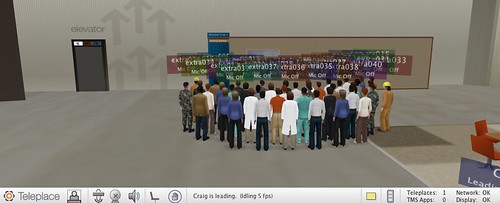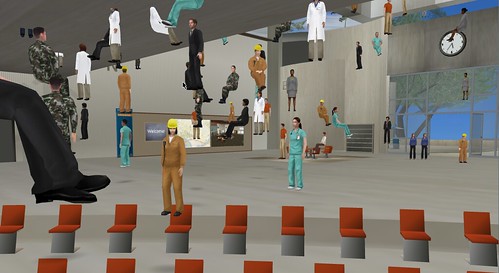Impressive Steve Jobs product presentations are built around a unifying theme. Really, the theme of our last version(*) is scalability for large institutions. This is largely architectural work hidden from most users, such as network topology or administrative support.
So far, actual users seem to have been most taken with the manifestation of this theme in the ability to control their colleagues.
*: After prototypes and two commercial versions.
You don’t need 3D nor realtime application collaboration to broadcast a meeting to a patient audience. Our Teleplace environment is a place for doing work in realtime with others, rather than a place for meetings per se. But part of working with others is having meetings, and so the results would be quite limited without the ability to have effective and sometimes quite large meetings. Then, because the day-to-day work is done within the environment that holds the meetings,
- the documents and media necessary for the meetings are always ready and up to date for reference and presentation,
- and action-items and conclusions from the meeting are immediately and directly ready to be used in subsequent work.
This synergy of a unified environment extends to being able to go back to things later for review or when you simply missed the meeting or work activity.
The drivers for having meeting in-world – time and travel — have not changed. Nor has the basic enabling technology such as live video, voice, and live documents. The new user-visible maturity has to do with controlling disruption in a meeting.
The minimum requirement for business meeting has always been about controlling access, which we do with IT-deparatement stuff like authentication, encryption, integration with corporate controls, and behind-the-firewall installations. But it turns out that the invited folks can be unintentionally disruptive, too.
A new set of meeting controls allow any participant (with authority) to become the meeting leader. The leader has one-gesture controls to bring everyone to a given place, including having them look at a particular display of interest. Late arrivals will automatically go there, too. Or the leader can force everyone to follow them around the space. (We’ve taken to calling it our posse.) I think it is important to let people explore a space on it’s own — sometimes even during a meeting — as long as there is a way to gather the flock when you need to. We had already had gestures to allow a user to go to a place or person, or to go with a person: the new stuff allows the leader to make this choice for the group. Again, I don’t think that it has been important to have large-meeting controls available while doing in-the-small collaborative work, but it is useful to be able to use the same application and space to do daily work and larger presentations. Once gathered, the leader can let people explore, or nail their feet to the floor at that location. The participants can be allowed to interact with what is visible, or they can be restricted from making changes.
Among the places to which people can be brought, are places that have seats. If you go or are brought to, e.g., a conference table that has seating, you are automatically assigned to a chair. I find the whole concept of seating for avatars to be weird. I don’t want to make virtual worlds that mirror the physical world — I want to to make them better. When possible, I want them to be free of the physical restrictions of the real world. Why clutter up a virtual environment with chairs and tables? And yet, people tell us that they get more tired when their avatar stands in a meeting than when they sit! Also, merely providing a conference table and usable chairs is enough to indicate to people that you want to discuss something together rather than having people wandering around, dancing, or playing with the virtual fish tank. And so, we’ve introduced chairs and self-selected, user-operated seating. Because taking the action of finding a seat can be invoked by going to a place with seats, and meeting leaders can send everyone to a given place, we also get a single gesture for a meeting leader to have everyone take a seat!
The leader can also mute everyone else, or any individuals. Muted or not, participants can signal that they want to speak, which annotates the person with a cancelable question mark symbol that everyone can see. The leader can unmute any individual. Even in a small group, it is handy to be able to mute the one guy with a buzz-killing open mic making feedback, or the one headset guy breathing heavy. (Often me.) The leader can also restrict text chat: for example, a teacher can directly stop students from passing notes, while at at other times it is very handy to be able to make a side comment without aurally disturbing the main flow.
The leader can also very quickly and spontaneously create a yes/no poll for the participants, which is a quick way to test or solidify agreement without disturbing the flow of the meeting. (I think brainstorming activities as being somewhat between daily collaborative work and a bit more formal meeting. For these we have tools for quickly creating and working with stickies, arrangements of topics, and multi-choice/multi-vote polls, too. Again, it’s handy to use the same environment for all these different forms of activity so that the results are there to be made use of in other activities.)
A lot of this stuff is available in specialized 2D meeting software, but I find those to be too restrictive. Part of the problem is that in some cases, you can only follow-the-leader. If you’re not the leader in software oriented towards group sales presentations, the most you can ever do is to text-chat a question. But more than that, even if I were allowed to do more, there simply isn’t that much to do. You don’t get the natural free-form interactive experience that a virtual world or telepresence system allows. But unlike the high-end telepresence systems, a virtual world does let your avatar do things that you cannot readily do in the physical world. So the idea is that when it is appropriate, to include but not require everything that’s possible in any meeting system.






This is fascinating. I like the part about people feeling less tired when their avatars can sit.
I’ve heard that at the Academy Awards show, there are professional seat-fillers who temporarily occupy the seats of anybody in the audience who steps out for a smoke or to use the rest room (so that there won’t be empty seats when the television cameras scan the audience). I wonder if you’re going to have to come up with a way to handle that situation also?
Indeed, I could see someone wanting seat-fillers at a virtual event (http://wetmachine.com/i…) that was open to the press.
It turns out that we do have internal technology that would work for that. For testing purposes, we have the ability to raise an arbitrary size crowd of robot users. (We rent virtual user machines on one of the commercial cloud computing platforms, and run the client application on each. Then we have a setting that makes that user run through a randomly timed set of random actions.) Both pictures above are using that technology, with the latter “Magritte” image being an early version when something went a little wrong. Notice that the names of the “users” in the first picture are “extraNN”? I also used “the crowd” to film http://wetmachine.com/i… from the comfort of my back patio with one laptop and no one else involved.
In the first picture, above, the meeting leader summoned everyone to come to a particular spot. If that spot had been an auditorium mostly filled with seats (of “real” avatars or robots), as many robots as would fit would have taken the empty seats.